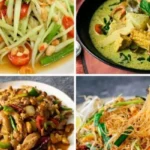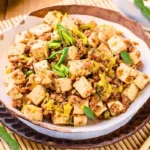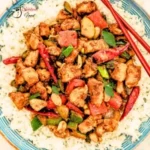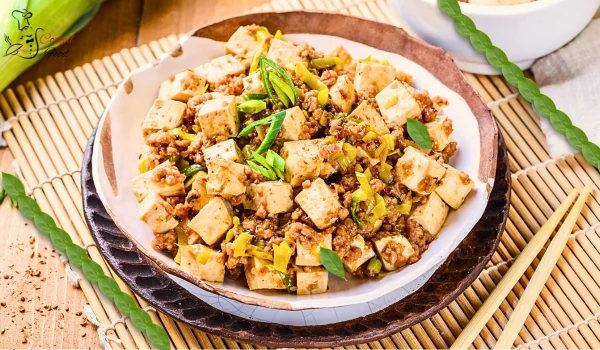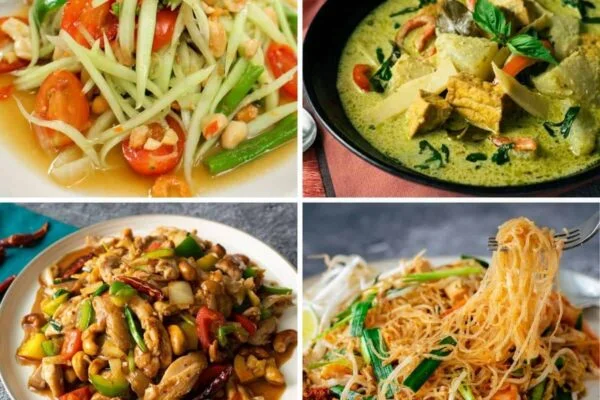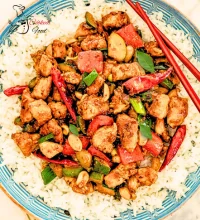A fiery and Aromatic Sichuan Classic
Considered a culinary masterpiece, Mapo Tofu—a dish connected with Sichuan cuisine—coordinates a symphony of scorching heat, savoury depth, and silken textures. This dish, which consists of soft tofu drenched in a rich, spicy, and very flavourful sauce, has enthralled palates all around and grown to be a mainstay in Chinese restaurants as a treasured home-cooked dinner. Examining the ingredients that have secured Mapo Tofu’s beloved and enduring classic status, this essay explores its intriguing beginnings, regional subtleties, sophisticated cooking techniques, and ongoing cultural relevance.
A Story of Pockmarked Ma and A Bridge of Fortune
The narrative of Mapo Tofu starts in Qing Dynasty (1644–1912) Chengdu, the energetic capital of Sichuan province. According to legend, a woman with a pockmarked face—thus “ma po,” or “pockmarked grandma”—run a little, modest eatery close to the Wanfu Bridge (万福桥), hence “Ten Thousand Blessings Bridge.” Travellers, businesses, and workers all flocked to this busy centre of activity, which generated an always ravenous customer flow.
As it was known, the “Pockmarked Grandma Chen’s Tofu Shop” provided reasonably priced, basic cuisine. The creative entrepreneur came up with a novel meal utilising easily available tofu, mixing it with ground pork, chilli oil, and fermented black beans one day confronting a dearth of ingredients but with hungry consumers to serve. The finished result was an unexpectedly good and enjoyable dinner that perfectly balanced numbing, savoury, and spicy tastes. Word of this unusual tofu dish travelled fast, and soon “Mapo Tofu” became a local sensation, intimately connected to its modest beginnings and the creativity of its maker. This genesis narrative gives the dish’s ongoing appeal by adding a layer of folklore and personal interest.
Sichuan Flavor’s essence is Ma, La, Xian, and Tang — A Quartet of Flavours
Four basic traits of Sichuan cuisine are exemplified by Mapo Tofu: ma (麻, numbing), la (辣, spicy), xian (鲜, fresh), and tang (烫, hot). This quartet of senses produces a deep, sophisticated taste experience that is both exciting and gratifying.
Ma (Numbing) Derived from Sichuan peppercorns (花椒, huājiāo), this distinct sensation—often described as a tingling or buzzing feeling—is Hydroxy-alpha-sanshool molecules found in these peppercorns interact with oral nerve receptors to produce the distinct numbing effect. This feeling is a unique sensory experience that improves the impression of other flavours, not only a lack of emotion.
Chilli peppers and chilli oil (辣椒油, làjiāoyóu) provide Mapo Tofu’s spicy spiciness. Although one can change the degree of spice to suit personal taste, a real Sichuan Mapo Tofu is supposed to be somewhat kicky. Chilli peppers’ capsaicin sets off mouth’s heat receptors, producing the searing sensation that defines spicy cuisine.
Xian (Fresh): Especially the tofu itself and the aromatics utilised in the sauce, this describes the vivid and fresh tastes of the components. Attaching this quality requires fresh ground spices and premium ingredients.
Tang (Hot) is the dish’s temperature, usually presented hot and straight forward. Along with improving the tastes, the heat adds to the whole sensory experience.
Mapo Tofu is unique and addicting because of this delicate mix of ma, la, xian, and tang, which produces a sophisticated and multi-layered taste sensation that entices customers back for more.
Key Components: Flavor’s Building Blocks
Making real Mapo Tofu requires a few basic ingredients:
Tofu, also known as dòufu: Usually used is soft or medium-firm tofu, which has a delicate and yielding texture that complements the rich, strong sauce really brilliantly. Acting as a sponge, the tofu absorbs the tastes of the sauce and develops to be really delicious on itself. Usually avoided since it is too delicate and will break during cooking is silken tofu.
Often mixed with chilli peppers, this fermented broad bean paste—dòubànjiàng—is the heart and soul of Mapo Tofu. It offers a rich, savoury, sophisticated taste basis that adds umami as well as saltiness. Achieving the real flavour character depends on good doubanjiang.
For the “ma” sensation, Sichuan Peppercorns (花椒, huājiāo) are not negotiable. The meal depends critically on their citrussy scent and numbing action.
Chilli Oil (辣椒油, làjiāoyóu) gives the meal heat and a vivid red colour, therefore improving its visual appeal and sharpening the spicy taste. Made from scratch, homemade chilli oil enhanced with different spices can add even more variety to the cuisine.
Usually pork or beef, ground meat (肉末, ròumò) gives the sauce savoury counterpoint to the spiciness and richness. Usually browning before adding to the sauce, the meat produces tasty browned chunks that enhance the general depth of flavour.
Techniques And Timing In The Art Of Preparation
Making real Mapo Tofu needs both meticulous attention to technique and timing.
Tofu blanching: To reduce extra water, firm the tofu, and eliminate any beany taste, blanch it in gently salted boiling water for a few minutes. This helps the tofu to better absorb the sauce’s flavours and keeps it from disintegrating during cooking.
Making the sauce calls for great attention. After the ground meat is browned, the doubanjiang is added and stir-fried until aromatic, so releasing its strong, savoury scent. Then included are chilli oil, garlic, and ginger, so building a fragrant basis for the sauce.
Adding the blanched tofu gradually to the sauce and simmering it for a few minutes lets it absorb the flavours. The tofu won’t break apart if you gently simmer it.
Usually used to thicken the sauce, a cornflour slurry produces a rich, glossy coating for the tofu. This also serves to unite the flavours.
“Dou” (勾芡, gōujiàn) is a fundamental Sichuan technique whereby two steps of cornstalk slurry addition produces a layered texture to the sauce.
Usually topped with chopped scallions (葱花, cōnghuā) and a scattering of freshly powdered Sichuan peppercorns for extra perfume, taste, and visual appeal, the dish is
Globally Popularity and Cultural Relevance
Representing Sichuan cuisine’s robust flavours, distinctive cooking techniques, and rich cultural legacy, Mapo Tofu has evolved into a potent emblem of the cuisine. Mapo Tofu is now consumed in Chinese restaurants and homes all around, therefore its appeal has gone much beyond China. Strong and sophisticated tastes of the meal have made it a favourite among spice aficionados and daring diners, therefore exposing many to the special sensations of Sichuan cuisine. With chefs including it into several gastronomic concoctions, it has also become a popular dish in fusion cuisine.
Modern Interpretations and Culinary Innovations
Respected its roots, modern chefs and home cooks keep experimenting with Mapo Tofu, stretching its possibilities. While some varieties explore diverse flavour combinations using ingredients like black bean garlic sauce or fermented chilli pastes, others include current culinary methods as sous vide or molecular gastronomy. Using other varieties of tofu, such smoked tofu or even silken tofu made with great care, is also becoming more and more common. Vegetarian and vegan forms are still somewhat popular since they show the great flexibility of the cuisine. To replicate the texture and umami of ground meat, these variations sometimes call for finely chopped mushrooms, water chestnuts, or other vegetables.
Summary:
A Fiery legacy of Taste and Cultural Interchange
The intriguing mix of tastes, textures, and rich cultural relevance of Mapo Tofu makes it always appealing. Born from the inventiveness of the “Pockmarked Grandma,” from its modest origins in a small Chengdu restaurant near the Wanfu Bridge, to its present global culinary icon, this dish never fails to enthrals and inspire. It is evidence of the ability of basic components, well combined, to produce a very remarkable gastronomic experience. The legacy of the meal is spicy tastes, numbing sensations, and a rich cultural background. Mapo Tofu is a timeless classic, a monument to the ongoing force of Sichuan cuisine whether eaten at a famous Sichuan restaurant, ordered as take-out, or lovingly made in a home kitchen. This dish never fails to thrill and challenge palates; it is a flaming legacy that will surely blaze brilliantly for next generations, promoting global cultural interaction and gastronomic respect.

